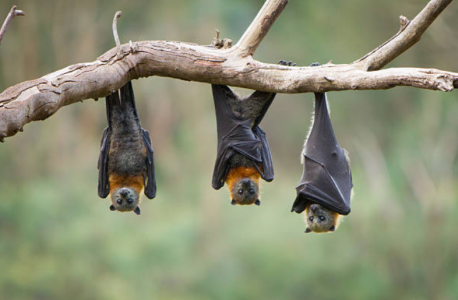Routine encounter turns deadly as bat virus fears resurface
By
Gian T
- Replies 0
What started as a simple, compassionate gesture has ended in a devastating loss for one family, following a rare but fatal illness.
The incident has shaken the community and sparked fresh concerns about the dangers of close encounters with local wildlife.
Many are now questioning whether existing protections are enough to prevent such tragedies.
Craig Nolte (56), a well-known carpenter and beloved family man, was simply trying to help when disaster struck.
In October last year, a bat became trapped on the verandah of his Ballina home.
As many of us would, Craig stepped in to free the distressed animal. In the process, he was bitten—a moment with unimaginable consequences.
Shortly after the incident, Craig did all the right things. He sought medical attention and received the recommended post-exposure treatment: a prophylaxis immunoglobulin injection and a series of vaccines.
These measures are designed to prevent the onset of Australian bat lyssavirus (ABLV), a virus closely related to rabies and almost always fatal once symptoms appear.
Despite these precautions, Craig’s condition deteriorated. Within weeks, he developed symptoms and was placed on life support.
His wife, Robyn, who runs a local childcare centre, shared her grief and confusion on social media, revealing that NSW Health was still 'grappling' with how the treatment failed.
'RIP my love, my best friend,' she wrote in a moving tribute.
NSW Health has since confirmed that Craig received the correct initial treatment and has launched an investigation into the circumstances surrounding his illness.
'Post-exposure prophylaxis for lyssavirus exposure includes both immunoglobulin and at least four vaccines given over several weeks,' a spokesperson said.
'The treatment is very safe and has been proven worldwide to be highly effective.' Yet, in this tragic case, it was not enough.
Craig’s death marks only the fourth recorded case of ABLV in Australia, and heartbreakingly, all have been fatal—including the case of an eight-year-old Queensland boy in 2013.
Bats carry the virus, which is transmitted through bites or scratches. Once symptoms develop, there is no known cure.
Friends and family have been left reeling. Craig was remembered as a 'hard worker,' 'gentleman,' and 'big-hearted' outdoorsman.
'He wouldn’t have been scared of a bat, he was six feet four,' one friend recalled.
Ballina Mayor Sharon Cadwallader echoed the community’s grief and called for answers: 'Any loss in our community to a preventable occurrence is heartbreaking and a thorough investigation needs to be carried out as to why the vaccine didn’t work.'
The tragedy has also prompted renewed warnings from health authorities. NSW Health urges the public never to handle bats, even if they appear injured or in distress.
Instead, experts recommend contacting local wildlife rescue groups, whose trained staff can safely manage these situations.
Large bat colonies are common in many parts of NSW, including Sydney’s Centennial Park, Burnt Bridge Creek in Balgowlah, and Parramatta Park.
ABLV is a virus found in Australian bats that is almost identical to the rabies virus. It can be transmitted to humans through bites or scratches, and, like rabies, it is almost always fatal once symptoms appear.
The best protection is prevention: avoid direct contact with bats, and seek immediate medical attention if bitten or scratched.
We extend our deepest condolences to Craig’s family, friends, and the Ballina community.
We hope that answers will come and that greater awareness will help prevent future tragedies.
 Have you ever had a close encounter with a bat or other native wildlife? Do you have questions or concerns about ABLV or other zoonotic diseases? Share your thoughts, experiences, or condolences in the comments below.
Have you ever had a close encounter with a bat or other native wildlife? Do you have questions or concerns about ABLV or other zoonotic diseases? Share your thoughts, experiences, or condolences in the comments below.
Read more: ‘We have no idea how it got in’: Mystery visitor leaves couple scrambling
The incident has shaken the community and sparked fresh concerns about the dangers of close encounters with local wildlife.
Many are now questioning whether existing protections are enough to prevent such tragedies.
Craig Nolte (56), a well-known carpenter and beloved family man, was simply trying to help when disaster struck.
In October last year, a bat became trapped on the verandah of his Ballina home.
As many of us would, Craig stepped in to free the distressed animal. In the process, he was bitten—a moment with unimaginable consequences.
Shortly after the incident, Craig did all the right things. He sought medical attention and received the recommended post-exposure treatment: a prophylaxis immunoglobulin injection and a series of vaccines.
These measures are designed to prevent the onset of Australian bat lyssavirus (ABLV), a virus closely related to rabies and almost always fatal once symptoms appear.
Despite these precautions, Craig’s condition deteriorated. Within weeks, he developed symptoms and was placed on life support.
'RIP my love, my best friend,' she wrote in a moving tribute.
NSW Health has since confirmed that Craig received the correct initial treatment and has launched an investigation into the circumstances surrounding his illness.
'Post-exposure prophylaxis for lyssavirus exposure includes both immunoglobulin and at least four vaccines given over several weeks,' a spokesperson said.
'The treatment is very safe and has been proven worldwide to be highly effective.' Yet, in this tragic case, it was not enough.
Craig’s death marks only the fourth recorded case of ABLV in Australia, and heartbreakingly, all have been fatal—including the case of an eight-year-old Queensland boy in 2013.
Friends and family have been left reeling. Craig was remembered as a 'hard worker,' 'gentleman,' and 'big-hearted' outdoorsman.
'He wouldn’t have been scared of a bat, he was six feet four,' one friend recalled.
Ballina Mayor Sharon Cadwallader echoed the community’s grief and called for answers: 'Any loss in our community to a preventable occurrence is heartbreaking and a thorough investigation needs to be carried out as to why the vaccine didn’t work.'
The tragedy has also prompted renewed warnings from health authorities. NSW Health urges the public never to handle bats, even if they appear injured or in distress.
Instead, experts recommend contacting local wildlife rescue groups, whose trained staff can safely manage these situations.
ABLV is a virus found in Australian bats that is almost identical to the rabies virus. It can be transmitted to humans through bites or scratches, and, like rabies, it is almost always fatal once symptoms appear.
The best protection is prevention: avoid direct contact with bats, and seek immediate medical attention if bitten or scratched.
We extend our deepest condolences to Craig’s family, friends, and the Ballina community.
We hope that answers will come and that greater awareness will help prevent future tragedies.
Key Takeaways
- Father-of-two Craig Nolte, 56, from Ballina, died after contracting Australian bat lyssavirus (ABLV) from a bat bite, despite receiving the recommended immunoglobulin injection and vaccine.
- NSW Health is investigating how the virus proved fatal despite Mr Nolte receiving post-exposure treatment, with his case marking the first recorded in NSW and the fourth in Australia overall.
- The tragedy has raised concerns and calls for answers from Mr Nolte’s family and local officials, especially regarding why the vaccine didn't work in this instance.
- Health authorities are urging the public not to handle or rescue injured bats, advising people to contact local wildlife rescue experts instead, as ABLV has no known cure and previous Australian cases have also been fatal.
Read more: ‘We have no idea how it got in’: Mystery visitor leaves couple scrambling








